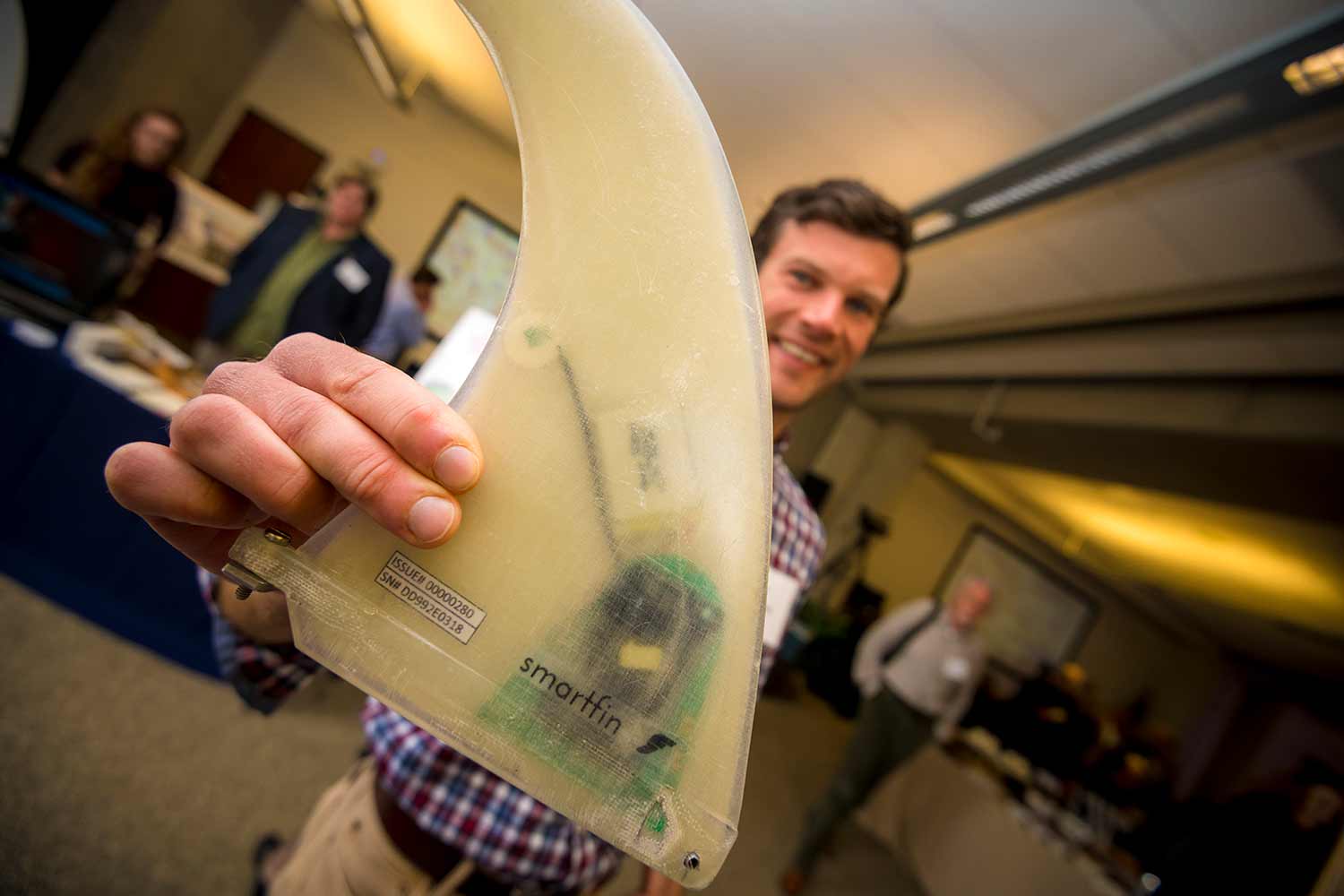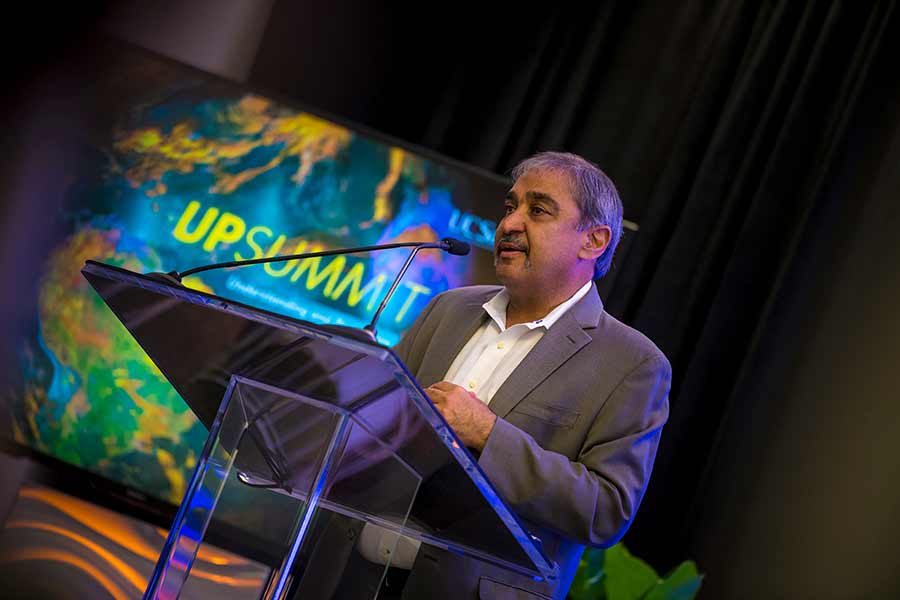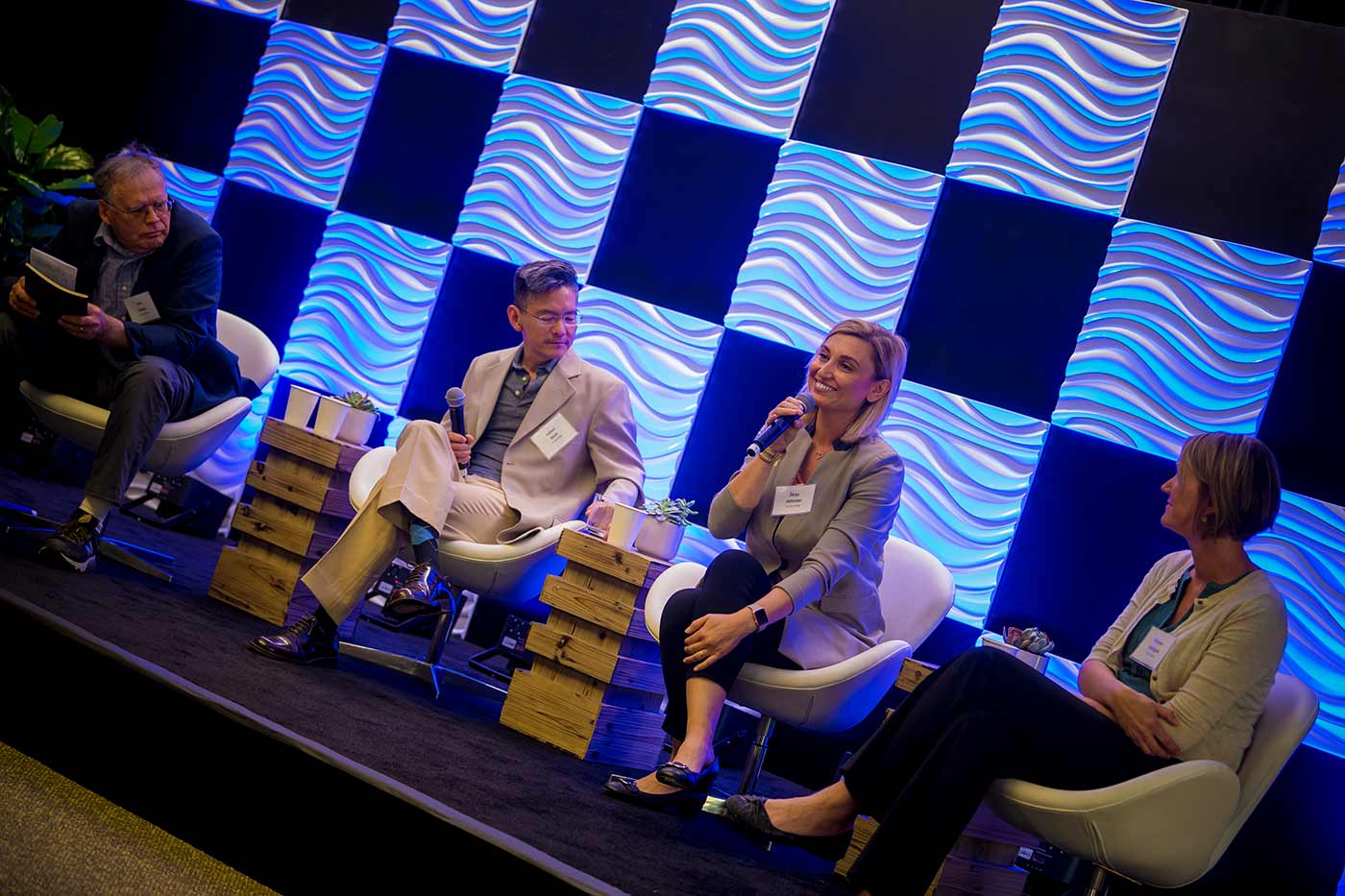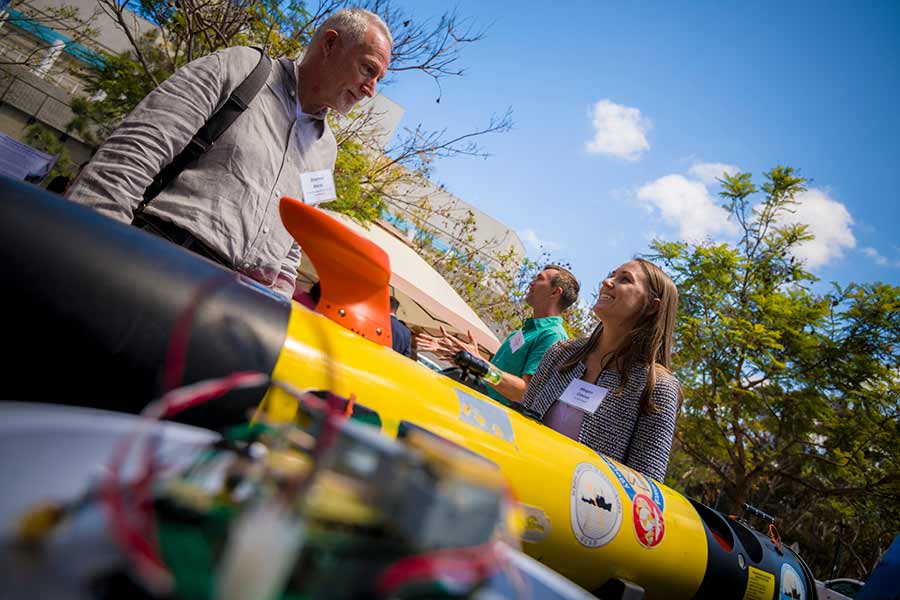
By:
- Lauren Fimbres Wood
Published Date
By:
- Lauren Fimbres Wood
Share This:

Phil Bresnahan of Scripps Institution of Oceanography at UC San Diego showcases the Smartfin at the inaugural UP Summit. Smartfin is a surfboard fin equipped with sensors to measure water temperature and other oceans parameters. Photos by Erik Jepsen/UC San Diego Publications
Campus Summit Encourages Collaboration to Solve Environmental Woes
Inaugural UP Summit brought together researchers and policymakers for the good of the planet
From a microgrid on campus that allows UC San Diego to generate most of its own energy to studies of pollution transport in the air and local beaches, the campus is home to major scientific and technological advances to understand and protect the planet, starting with Southern California.

UC San Diego Chancellor Pradeep K. Kholsa welcomes attendees at the UP Summit.
This research was showcased May 17 at the inaugural UP Summit, to inspire a dialogue about how UC San Diego researchers are contributing to find solutions to environmental challenges.
This research to understand and protect the planet is a cornerstone of UC San Diego’s strategic research themes identified during the university’s strategic planning process in 2014. This plan identified where UC San Diego has the best experience and most potential for positively impacting society and the environment.
The invite-only audience at the UP Summit was comprised of a group that can take this research and turn it into action—political leaders, elected officials, agency and tribal representatives, non-profit partners and philanthropic supporters.
“Even when we understand the science and we have the technology, deploying it requires strategic policy decisions,” said UC San Diego Chancellor Pradeep K. Khosla. “It cannot be done in a vacuum.”
The summit featured two panel discussions on key issues affecting Southern California. The first was moderated by Mark Merrifield, director of the Center for Climate Change Impacts and Adaptation at Scripps Institution of Oceanography, and addressed extreme weather and atmospheric rivers, which can bring most of California’s water supply in only a few weather events a year, and pollution transport via the oceans and atmosphere. The panelists—coastal oceanographer Sarah Giddings, atmospheric chemist Kim Prather, and project scientist Aneesh Submaranian of the Center for Western Weather and Water Extremes—spoke on the how their research is interconnected, and where more research needs to be done to understand complex problems.

UC San Diego researchers Dan Cayan, James Nieh, Ilkay Altintas and Kristen Guirguis participate on a panel interdisciplinary research around climate change, wildfire modeling and ecological impacts in our region.
“When ocean pollution happens, the beaches are closed and they tell people ‘don’t go swimming, don’t go surfing,’ but they don’t tell you not to breathe,’” noted Prather, director of the Center for Aerosol Impacts on Chemistry of the Environment at UC San Diego. “You might want to think about the air you are breathing in [during an ocean pollution event]. When waves break, they are delivering a cocktail into the atmosphere. We don’t know if it’s good or bad for you, and we are starting to look at that now.”
The second panel discussed issues on land—including concerns about what pesticides are doing to the honeybee population, climate change impacts to the region, and how improved collaboration between fire departments throughout the state has led to better wildfire monitoring and modeling. Moderated by Keith Pezzoli, who directs UC San Diego’s Urban Studies and Planning Program and the Bioregional Center for Sustainability Science, Planning and Design, panelists included Scripps climate scientists Dan Cayan and Kristen Guirguis, ecologist James Nieh, and data scientist Ilkay Altintas.

Scripps Institution of Oceanography postdoctoral scholar Megan Cimino (right) speaks with Steven Wertz, an environmental scientist with the California Department of Fish and Wildlife, about remote operated vehicles used in research. The science and technology showcase was part of an expo held at the UP Summit.
Altintas spearheads WIFIRE, a program that merges observations and data with computational techniques to predict where and how fast a wildfire will spread.
“I was inspired to begin this research after 2003 when San Diego saw these big fires,” said Altintas, director for the Center of Excellence in Workflows for Data Science at the San Diego Supercomputer Center. “UC San Diego had a great testbed with Scripps and HPWREN to bring together fire imagery and data with models. The goal was to close the loop between observations and models, to create real-time fire models.”
This interdisciplinary research is now paying off, through direct partnerships with fire departments throughout the state, including a Los Angeles County fire chief that tracked down Altintas to collaborate after learning about her work. Altintas provided predictive maps for the 2017 fires from Napa to San Diego County to assist first-responders by creating simulations of the spread of wildfires.
Attendees were able to see this science and technology in a hands-on expo. Expo stations included information on UC San Diego’s algae biotechnology innovations, demonstrations of LiDAR technology monitoring and tracking coastal cliff erosion in San Diego County, and instrumentation used in the ocean to measure waves and ocean temperature and monitor ocean coastal conditions.
“The County has partnered with UC San Diego on several upgrades to the camera and data networks that monitor for wildfires, which are proving to be wise investments given the more extreme weather conditions we are seeing,” said San Diego County Supervisor Ron Roberts. “Attending the summit provided me the opportunity to learn about other advances in science and technology that could have direct health and environmental implications for protecting our region.”
According to event organizers, the goal of this summit was not just to show off the work that was done, but to foster a dialogue between the researchers and the policy makers. The approximately 100 attendees were given opportunities to network and converse throughout the event. The hope is that by learning more about what the science is capable of and what they community needs are, more solutions can be put into action to protect the planet for future generations.
“We’re all here trying to solve problems that are impacting us today,” said Khosla. “It’s going to impact our kids, and it’s really going to impact our grandkids if we don’t take care of them.”
Share This:
You May Also Like
Stay in the Know
Keep up with all the latest from UC San Diego. Subscribe to the newsletter today.


